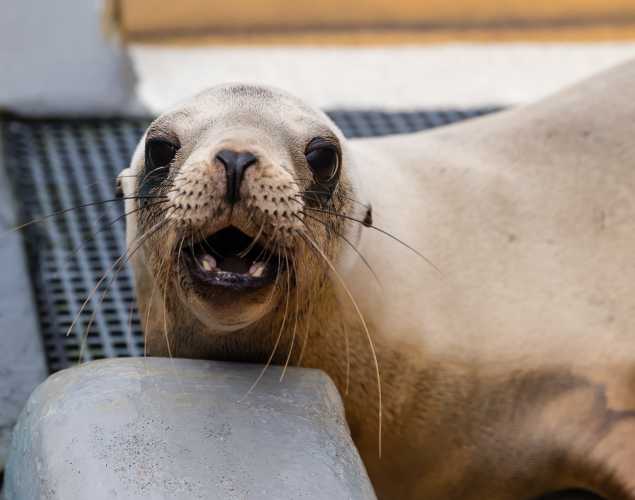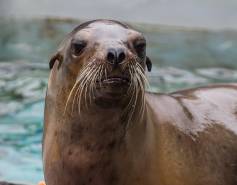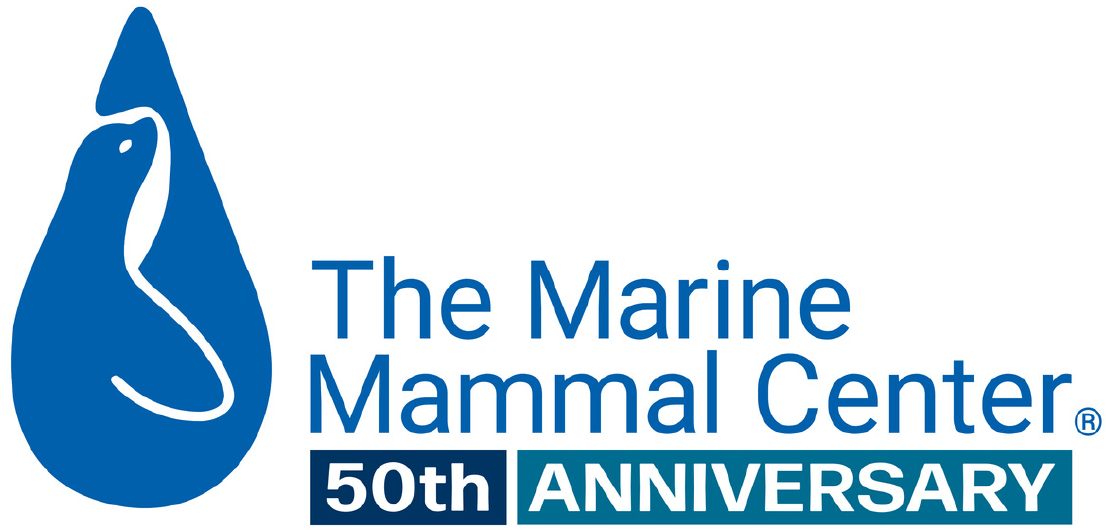
Cancer - High Prevalence in California Sea Lions
Using three decades of data collection and analysis, the Center’s research revealed an extremely high prevalence of cancer in California sea lions.
A specific cancer of epithelial origin was first diagnosed in California sea lions at The Marine Mammal Center in 1979. Since then, researchers have determined that approximately 20 percent of adult stranded sea lions that die have cancer.
While there is more to be learned about the complex factors that play into the development of this disease, what we learn from these animals contributes to research that could eventually lead to cures for humans.
How Do Sea Lions Get Cancer?
Researchers at the Center discovered that these sea lions are infected with a herpesvirus similar to one that causes Kaposi's sarcoma in humans. In order to study this cancer, our researchers collect samples from each patient, fostering greater understanding of what might be causing the alarming cancer occurrence—including environmental and genetic factors.
Cancer development is a multi-step process during which damage to the genetic material of cells (DNA) arises from the interaction between a number of factors. These may include environmental factors such as chemical contaminants, infection by tumor-promoting viruses and the animals' own genetic predisposition to develop the disease.
People with Kaposi’s sarcoma generally have been smokers or exposed to toxins, so the latter may apply to marine mammals. High levels of persistent organic pollutants such as DDT and PCBs have been found in the blubber of California sea lions.
Using samples collected from hundreds of patients, the Center's researchers proved that a sexually transmitted herpesvirus causes the alarming cancer occurrence, and that pollutants such as PCBs and DDT play a significant role both as primary carcinogens (or cancer-causing substances) and as co-factors in the development of this cancer.
The research the Center conducts after the death of a sea lion with cancer is invaluable as this kind of work is not possible with human subjects. The Center's findings show that sea lion pups are exposed to PCBs while in utero, a factor that has important health effects later in their lives as PCBs can alter organ development.
In 2010, Center scientists brought together an array of international researchers to form the Sea Lion Cancer Consortium to further investigate this disease, and this work continues today.
Cancer Research at The Marine Mammal Center
Cancer was first diagnosed in California sea lions at The Marine Mammal Center in 1979. Since then, our veterinarians and scientists have contributed to a number of scientific papers on cancer in marine mammal populations.
{"image":"\/Animals\/Patients\/California sea lions\/2018\/cropped-images\/csl-leadbelly-by-bill-hunnewell-c-the-marine-mammal-center-664-0-2502-1954-1607626905.jpg","alt":"California sea lion","title":"Contaminant Exposure and Herpesvirus Associated with Cancer in Wild Sea Lions","link_url":"https:\/\/www.marinemammalcenter.org\/publications\/contaminant-exposure-and-herpesvirus-associated-with-cancer-in-wild-sea-lions","label":"Research Paper","type":"publication"}

Contaminant Exposure and Herpesvirus Associated with Cancer in Wild Sea Lions
Read More{"image":"\/Animals\/Wild\/California sea lion\/cropped-images\/csl-on-a-rock-shutterstock-191-0-3072-2400-1617060454.jpg","alt":"California sea lion on a rock","title":"Unlocking the Role of a Genital Herpesvirus in California Sea Lion Cervical Cancer","link_url":"https:\/\/www.marinemammalcenter.org\/publications\/unlocking-the-role-of-a-genital-herpesvirus-in-california-sea-lion-cervical-cancer","label":"Research Paper","type":"publication"}

Unlocking the Role of a Genital Herpesvirus in California Sea Lion Cervical Cancer
Read More{"image":"\/Animals\/Wild\/California sea lion\/cropped-images\/sea-lion-mom-pup-shutterstock-338-0-3131-2446-1603926801.jpg","alt":"California sea lion mom and pup","title":"Effects of In Vitro Exposure to PCBs on California Sea Lions","link_url":"https:\/\/www.marinemammalcenter.org\/publications\/effects-of-in-vitro-exposure-to-pcbs-on-california-sea-lions","label":"Research Paper","type":"publication"}

{"image":"\/Animals\/Patients\/California sea lions\/cropped-images\/csl-resting-c-the-marine-mammal-center-605-0-3523-2751-1603927376.jpg","alt":"California sea lion resting on the pen floor with a young sea lion in the background","title":"Prevalence of Cancer in Stranded California Sea Lions (2005-2015)","link_url":"https:\/\/www.marinemammalcenter.org\/publications\/prevalence-of-cancer-in-stranded-california-sea-lions","label":"Research Paper","type":"publication"}

{"image":"\/Animals\/Wild\/California sea lion\/cropped-images\/csl-monterey-photo-c-bill-hunnewell-1984-1534-1582-1236-1603927643.jpg","alt":"Group of sea lions on a rock","title":"No Evidence that Cancer in Sea Lions Is Spread Through Clonal Transmission","link_url":"https:\/\/www.marinemammalcenter.org\/publications\/no-evidence-that-cancer-in-sea-lions-is-spread-through-clonal-transmission","label":"Research Paper","type":"publication"}

{"image":"\/Animals\/Patients\/California sea lions\/2020\/cropped-images\/csl-boycrus-by-bill-hunnewell-c-the-marine-mammal-center-0-0-3110-2429-1603927870.jpg","alt":"California sea lion","title":"California Sea Lions as a Model for Studying a Common Cancer","link_url":"https:\/\/www.marinemammalcenter.org\/publications\/california-sea-lions-as-a-model-for-studying-a-common-cancer","label":"Research Paper","type":"publication"}

Cancer in the News
{"image":"\/Animals\/Patients\/California sea lions\/cropped-images\/csl-by-bill-hunnewell-c-the-marine-mammal-center-0-0-3110-2430-1639515407.jpg","alt":"California sea lion","title":"AP News: Banned Decades Ago, PCBs Still Posing Threat to Wildlife","link_url":"https:\/\/www.marinemammalcenter.org\/news\/ap-news-banned-decades-ago-pcbs-still-posing-threat-to-wildlife","label":"In the News","date":"2021-12-13 01:00:00","type":"news"}

AP News: Banned Decades Ago, PCBs Still Posing Threat to Wildlife
December 13, 2021
Read More{"image":"\/Animals\/Patients\/California sea lions\/cropped-images\/csl-by-bill-hunnewell-c-the-marine-mammal-center-2-0-1031-1794-1401-1603916128.jpg","alt":"California sea lion","title":"Reuters: California Sea Lions Face 'Unprecedented Rate of Cancer'","link_url":"https:\/\/www.marinemammalcenter.org\/news\/reuters-california-sea-lions-face-unprecedented-rate-of-cancer","label":"In the News","date":"2021-06-08 02:00:00","type":"news"}

Reuters: California Sea Lions Face 'Unprecedented Rate of Cancer'
June 8, 2021
Read More{"image":"\/Animals\/Wild\/California sea lion\/cropped-images\/csl-diving-underwater-shutterstock-118-6-4171-3258-1618528450.jpg","alt":"California sea lions diving underwater","title":"CBS News: How a Shocking Environmental Disaster Was Uncovered Off the California Coast After 70 Years","link_url":"https:\/\/www.marinemammalcenter.org\/news\/cbs-news-how-a-shocking-environmental-disaster-was-uncovered-off-the-california-coast-after-70-years","label":"In the News","date":"2021-04-12 02:00:00","type":"news"}

CBS News: How a Shocking Environmental Disaster Was Uncovered Off the California Coast After 70 Years
April 12, 2021
Read More{"image":"\/Animals\/Patients\/California sea lions\/2011\/cropped-images\/csl-superstition-photo-c-the-marine-mammal-center-0-0-714-558-1612227061.jpg","alt":"California sea lion Superstition","title":"LA Times: Sea lions are dying from a mysterious cancer. The culprits? Herpes and DDT","link_url":"https:\/\/www.marinemammalcenter.org\/news\/la-times-sea-lions-are-dying-from-a-mysterious-cancer","label":"In the News","date":"2021-01-31 01:00:00","type":"news"}

LA Times: Sea lions are dying from a mysterious cancer. The culprits? Herpes and DDT
January 31, 2021
Read More